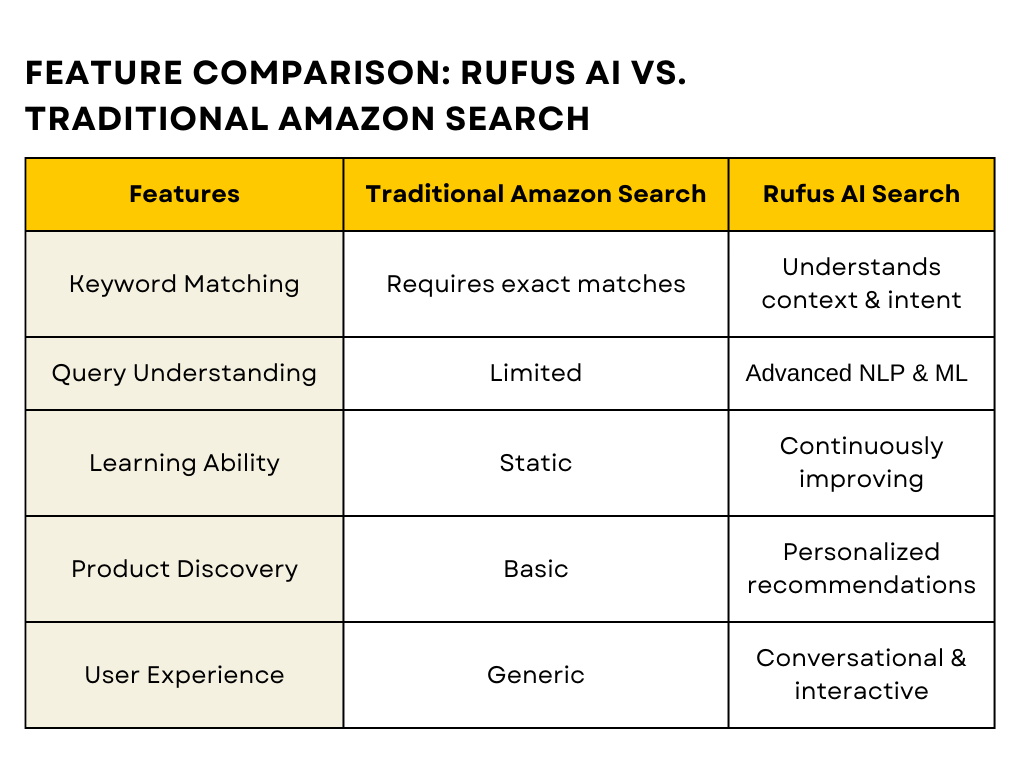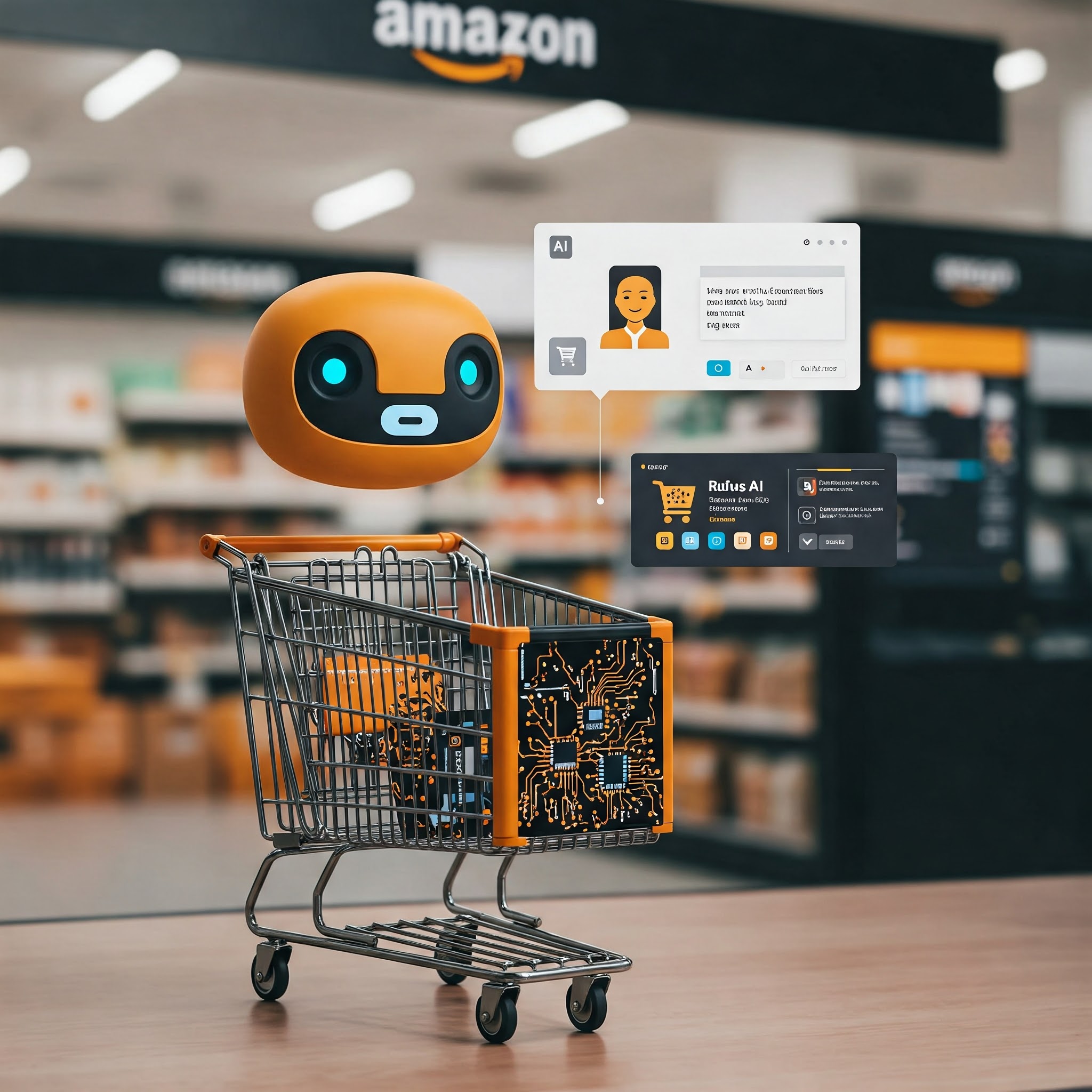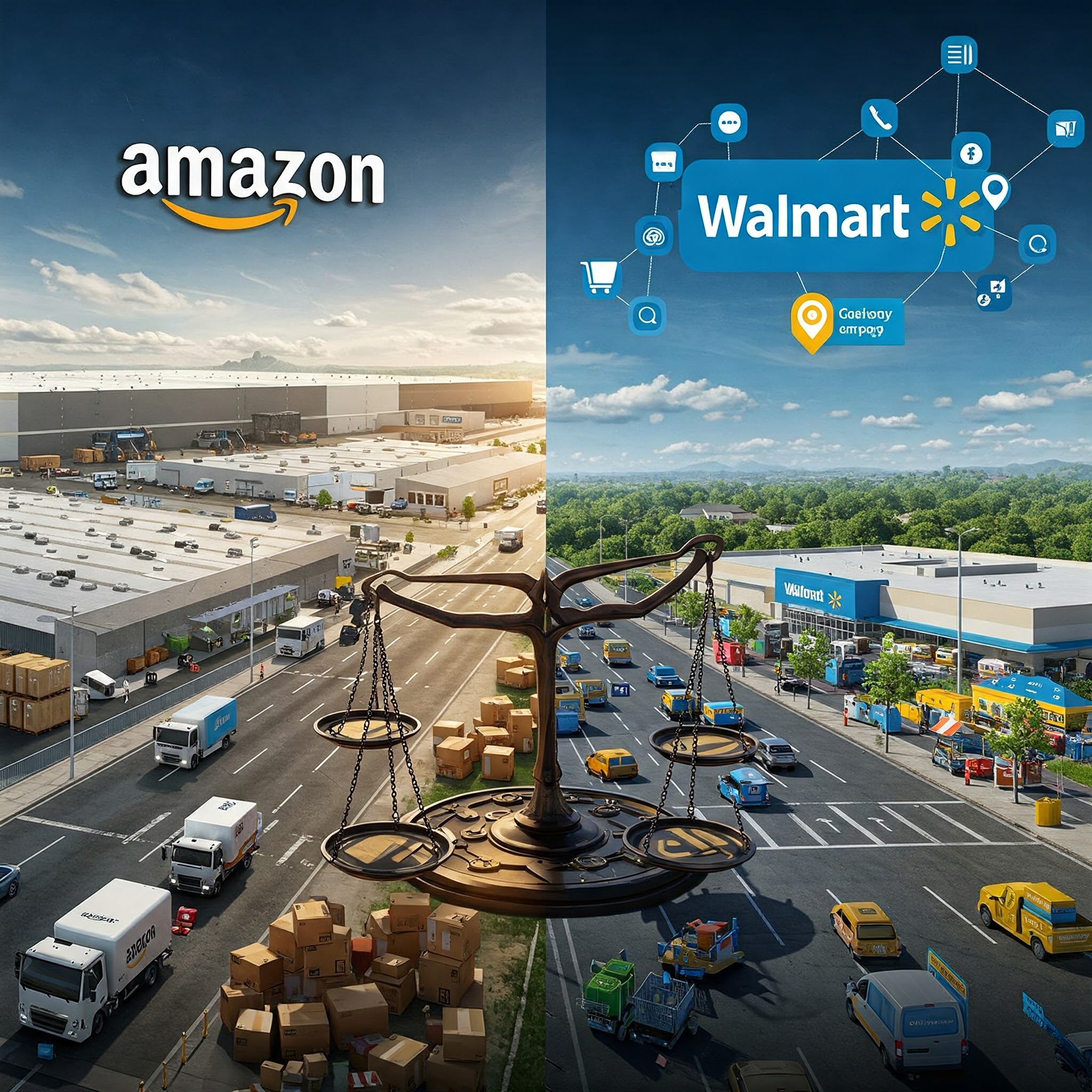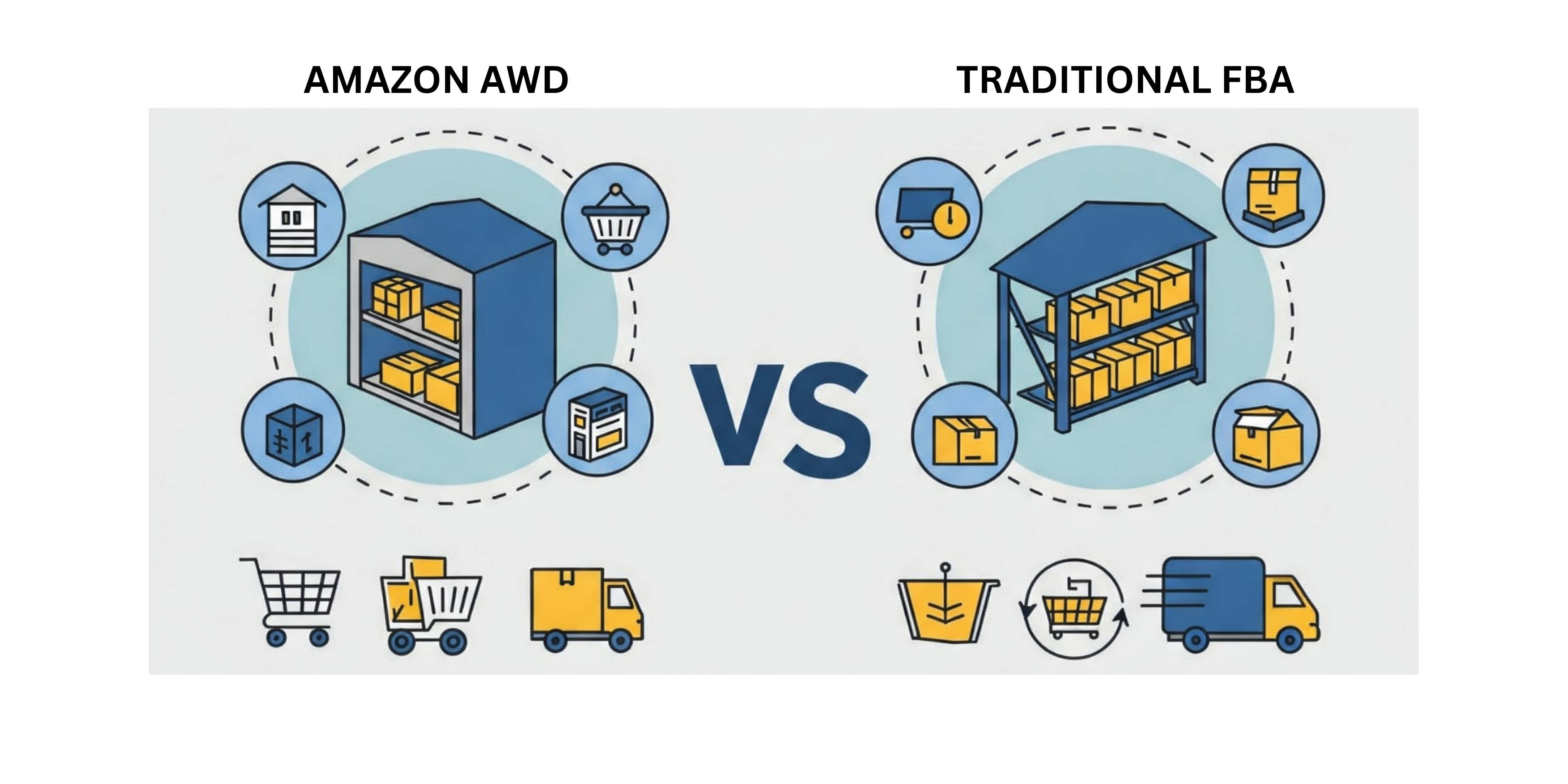Introduction
In the ever-evolving landscape of e-commerce, Amazon has consistently set the standard for innovation and customer satisfaction. A major player in this journey has been Amazon's integration of artificial intelligence (AI), revolutionizing the way we shop online. One of its latest innovations is Amazon Rufus AI, a powerful new system designed to enhance the online shopping experience by providing smarter, more personalized product search results.
This blog aims to provide a comprehensive guide to understanding how Amazon Rufus AI is changing the game for both consumers and sellers on Amazon. We’ll explore how this AI-driven search system works, the technology behind it, and most importantly, why it’s crucial for sellers to optimize their product listings to align with Rufus. As Amazon continues to embrace AI to meet the needs of its massive customer base, staying ahead of the curve by adapting to these innovations is key to sustained success.
For sellers on Amazon, understanding and leveraging Amazon Rufus AI could mean the difference between getting lost in the crowd and standing out in a competitive market. So, whether you're a seasoned seller or just starting, this blog will guide you on how to navigate this new era of e-commerce.
What is Amazon Rufus AI?
Amazon’s Rufus AI is a next-generation AI-powered search assistant designed to enhance the online shopping experience. Unlike traditional search algorithms, which rely primarily on exact keyword matches, Rufus goes a step further by understanding the intent and context behind a user’s search. This ability to interpret natural language queries makes it a more intelligent and accurate tool for finding products.
How Does Rufus Differ from Traditional Search?
Traditional Amazon search algorithms primarily focus on exact keyword matching. For instance, if a user searches for "wireless Bluetooth headphones," the search results would primarily show listings that contain that exact phrase, regardless of how well the product matches the user's actual needs.
Rufus, however, interprets the query in a more sophisticated way. If a shopper searches for "best laptop for video editing," Rufus doesn't just look for the words "laptop" and "video editing." Instead, it understands that the intent behind the search is to find laptops that are particularly suited for video editing. As a result, Rufus will show relevant laptops based on user intent, even if the exact keywords aren’t in the product title or description.
Example:
If a shopper asks, “How do you remove gel nails?” Rufus can interpret that the shopper is looking for acetone or nail care kits, even though the exact term "gel nail remover" may not appear in the product listing. This deep understanding of context and intent is what sets Amazon Rufus AI apart from traditional search methods.
How Does Amazon Rufus Work?
Amazon Rufus AI integrates a variety of advanced technologies that allow it to process, understand, and predict the most relevant results for shoppers. Below, we’ll break down the core components that make Amazon Rufus AI so effective at delivering personalized search results:
A. Contextual Understanding & NLP Integration
One of the biggest innovations behind Rufus is its ability to understand natural language processing (NLP). Rather than focusing solely on keywords, Rufus looks at the context of a query. It understands how humans phrase questions and how different terms relate to each other.
Example: Let’s say a user searches for "best shoes for marathon training." Instead of only looking for exact keyword matches like "marathon shoes," Rufus interprets the user's intent to find shoes suitable for running long distances. Rufus will factor in product attributes like cushioning, support, durability, and breathability—key qualities needed for marathon training shoes.
This is a huge leap from traditional search systems, which might miss such contextual nuances.
B. Machine Learning & Personalization
Rufus also incorporates machine learning (ML) to refine its recommendations based on user behavior. When a user interacts with search results—whether it’s clicking on a product, asking a question, or making a purchase—Rufus learns from that behavior and adjusts future search results accordingly.
The AI constantly analyzes a user’s search history, browsing behavior, and purchase patterns to deliver more relevant results. For example, if a user frequently searches for gaming laptops, Rufus will prioritize those kinds of products in future searches for laptops or tech-related queries.
Rufus AI also refines ad recommendations based on user behavior. To maximize ROI, check out our Amazon PPC Management services
C. Semantic Search & Query Optimization
Rufus takes advantage of semantic search to understand the meaning behind a search query, rather than just matching the words in a query to keywords in the product listings.
Example: If a shopper searches for "affordable ergonomic office chair for long hours," Rufus uses its understanding of semantic meaning to identify the products most likely to meet the needs of the shopper. It recognizes that terms like affordable, ergonomic, and long hours are related to comfort and health, so it recommends products that align with those attributes.
The use of long-tail keywords (more specific search terms) and noun phrases (a combination of words describing a specific product) is critical for improving search ranking within Rufus. These components ensure that products are discoverable even when customers don’t use the exact terms listed in the product description.
Using tools like Helium 10 can help sellers track and optimize their product listings for AI-driven search engines like Rufus.
The Technology Behind Rufus AI
Amazon’s Rufus AI represents a significant leap in the way online searches work. The technology driving Rufus relies on cutting-edge AI techniques, primarily in Natural Language Processing (NLP) and semantic search algorithms.
A. Natural Language Processing (NLP) & AI Algorithms
Rufus uses Natural Language Processing to understand and interpret user queries. Traditional search engines rely on exact keyword matching, but Rufus goes a step further by analyzing the context of the search. NLP allows Rufus to understand the intent behind a query, even when words are used in ways that aren’t typical.
For example, when a shopper searches for "best workout shoes for women," Rufus can identify that the user is looking for running shoes, sports shoes, or footwear designed for physical activity, regardless of whether these exact terms are used. By breaking down the query into its components and understanding the relationships between these words, Rufus can recommend the most relevant products.
B. Semantic Matching & Ranking Algorithms
Rufus employs semantic matching to go beyond simple keyword matching. Semantic algorithms allow Rufus to evaluate the meaning of the words used in a search query and compare it with the meaning of the content on product listings.
For example, a search for "affordable ergonomic office chair for long hours" may not have an exact match in product titles. However, Rufus will still pull up relevant results based on the overall meaning of the query. This is made possible by deep learning models that continuously improve the accuracy of search results.
Ranking algorithms within Rufus take into account semantic similarity and relevance to determine the best products for a particular query. The system is constantly learning from user behavior, and as a result, the quality of results improves over time.
C. Real-Time Learning & Dynamic Adaptability
Rufus doesn't simply rely on static algorithms to deliver search results. The system is dynamic and continuously learns from real-time data, adjusting its behavior based on user interactions. For instance, if a large number of users are clicking on a specific product after searching for a certain term, Rufus takes note and adjusts its recommendations for similar queries.
This adaptability is powered by machine learning. By analyzing historical data and current user interactions, Rufus can offer increasingly accurate and personalized results. Over time, this leads to a more refined search experience for customers, making product discovery on Amazon more effective.
Rufus vs. Traditional Amazon Search

How Rufus Improves the Customer Experience
Amazon Rufus AI takes search results personalization to the next level. Unlike traditional search, which focuses solely on keyword matching, Amazon Rufus AI considers the context and intent behind queries, allowing customers to find the most relevant products even if they don’t use the exact keywords a seller might have used.
For example, a traditional search might struggle to link a search query like “best budget gaming laptop” to relevant products if they don’t match the keyword exactly. But with Amazon Rufus AI, the system can understand that the user is looking for a "cost-effective laptop with gaming capabilities," even if the product descriptions don’t explicitly mention “budget.”
Case Study Example: Increased Visibility After Optimizing for Rufus
A seller of gaming laptops who optimized their product listings by including detailed noun phrases like “affordable gaming laptops with high-performance graphics” saw a noticeable increase in visibility after Rufus was introduced. Their products began appearing in search results for queries they hadn’t even directly targeted, resulting in a higher click-through rate and, ultimately, more sales.
Why Amazon Rufus AI Matters for Sellers
A. Impact on Product Visibility & Sales
With Amazon’s transition to AI-powered search, the importance of ranking high on search results has never been more critical for sellers. Rufus doesn’t just match exact keywords; it prioritizes understanding user intent, meaning sellers must optimize their listings to be relevant to broader, context-based queries. The more contextually relevant your product listings are to common queries, the more likely they are to appear higher in search results.
The introduction of Rufus shifts the focus from keyword-heavy optimization to contextual and semantic relevance. Sellers who focus on using noun phrases, detailed descriptions, and addressing customer intent in their listings will have a better chance of getting noticed by the AI and ranking higher.
B. Conversational Queries & New SEO Practices
Today’s consumers are more likely to search in a conversational manner, asking questions like "What are the best eco-friendly backpacks?" or "How do I find a good budget-friendly laptop for work?" This means sellers must rethink their SEO strategies. Rather than focusing solely on keywords, product listings must be designed to answer these conversational queries, keeping in mind the context behind each search.
C. Personalized Recommendations & Higher Conversions
Rufus AI can provide personalized recommendations based on a user’s past behavior, like what they’ve purchased or what they’ve searched for before. This means that sellers have the opportunity to present their products to customers when they’re most likely to convert. By optimizing product listings for Rufus, sellers ensure their products are better positioned in front of the right buyers, which leads to higher conversion rates. AI-driven personalization is becoming an industry standard, as discussed in BigCommerce’s AI report
How Sellers Can Optimize for Amazon Rufus AI
Optimizing for Amazon’s Rufus AI requires a shift in strategy, particularly in how products are presented and how sellers structure their content. Here are some actionable steps to optimize for Rufus AI:
A. Noun Phrase Optimization (NPO)
Noun Phrase Optimization (NPO) is one of the most effective techniques for improving search rankings with Rufus. Unlike traditional SEO, which relies heavily on short keywords, Rufus prioritizes context and the intent behind searches, making long-tail keywords and noun phrases more important than ever.
For example, instead of listing a product as just “earbuds,” sellers should use a more detailed description like “wireless Bluetooth noise-canceling earbuds for workouts.” This longer, more descriptive phrase is more likely to match the intent behind complex search queries.
By using detailed noun phrases, sellers ensure that their product is indexed for a broader set of search queries, improving discoverability.
B. Inference Optimization (IO)
Inference Optimization (IO) is about linking product attributes to the inferred needs or benefits of potential buyers. Amazon Rufus AI doesn’t just search for specific terms but also infers what the customer might need based on their search history and browsing behavior.
For example, a seller offering a “high-speed USB-C charger” should use product titles and descriptions that emphasize its benefit, such as “Fast charging for smartphones and tablets.” This helps Rufus understand the product’s application and make it more likely to show up for a search query like “best charger for fast charging smartphones.”
C. Writing Conversational & Semantic Content
The use of conversational language is key when optimizing for Amazon Rufus AI. Sellers must craft their product listings to address customer intent directly and answer potential questions that customers may have. Structuring product descriptions as if you were answering a question will not only improve clarity but will also make your listings more relevant to semantic search.
For instance, instead of a generic product description like “ergonomic office chair,” a seller might write “This ergonomic office chair provides maximum comfort for long hours of sitting, ideal for work-from-home professionals.” This approach not only speaks to the customer’s intent but is also more likely to match the nuanced search queries customers are using with Rufus.
D. Visual Label Tagging (VLT) & Alt Text Optimization
Visuals are a critical component of product discovery, especially with the rise of image-based searches. Visual Label Tagging (VLT) and alt text optimization play a key role in how Rufus interprets images. By providing detailed descriptions for images using alt text, sellers can ensure their products are accurately categorized.
For example, an image of a “waterproof hiking backpack” should have alt text that specifies “Waterproof hiking backpack with multiple compartments for outdoor adventures.” This not only helps search engines understand the image but also enhances the overall product visibility on Amazon.
Potential Challenges & Limitations of Rufus AI
While Amazon Rufus AI presents significant advantages for both buyers and sellers, it’s not without its challenges. Sellers need to be aware of potential pitfalls as they navigate this new system.
A. Learning Curve for Sellers
Amazon Rufus AI requires a change in how sellers approach SEO and product listing optimization. It’s no longer enough to use traditional keyword strategies. Sellers must rethink their entire content approach, focusing on contextual and conversational optimization. This may require time and resources to adapt, particularly for sellers who are accustomed to more straightforward keyword-based optimization.
B. AI Bias & Query Misinterpretation
Like any AI system, Rufus is not perfect. While it’s designed to understand user intent, there’s always the risk of misinterpretation, especially with complex or ambiguous search queries. Sellers may find their products are not appearing for certain searches due to AI bias or misunderstanding of queries. It’s crucial for sellers to regularly monitor their listings and make adjustments to improve alignment with customer intent.
C. Need for Continuous Listing Updates
Amazon Rufus AI continuously evolves, which means that listings need to be updated frequently to stay aligned with its changing algorithms and search behaviors. Sellers must remain proactive, ensuring that product descriptions, images, and keywords are optimized for new trends and shifts in consumer search patterns. Failure to do so could result in lower visibility and lost sales.
D. Competition Among Sellers
As more sellers adopt Rufus-optimized strategies, the competition for prime search result positions will increase. Early adopters who have already optimized for the AI will likely have a competitive edge. Sellers who delay adopting these strategies may find it harder to compete as Rufus continues to gain prominence.
Keeping up with AI-driven search algorithms can be complex. Our Amazon Account Management services ensure sellers stay ahead of these constant updates
The Future of Amazon Rufus & AI in E-Commerce
A. Voice Search & Alexa Integration
As voice search becomes increasingly popular, the integration of Amazon Rufus AI with Amazon Alexa will open up new possibilities for customers to shop hands-free. This integration will likely push sellers to focus even more on natural language queries and conversational content. Voice-based queries tend to be longer and more specific, which further emphasizes the importance of conversational and contextually relevant listings.
B. Visual Search Advancements
In the near future, visual search will play a much larger role in how customers discover products. Amazon Rufus AI’s ability to interpret images, combined with advancements in image recognition technology, will allow customers to search for products by image, enhancing the shopping experience.
Sellers who use clear and descriptive images with alt text will have a significant advantage in this evolving landscape. The integration of visual search into Amazon’s search engine is likely to further shift the way product discovery works, with AI understanding images in the same way it interprets text-based queries.
C. AI-Driven Personalized Shopping Experiences
Looking ahead, Amazon Rufus AI will continue to refine its ability to offer highly personalized shopping experiences. As AI gets better at understanding customer preferences, buying history, and even browsing behavior, product recommendations will become more tailored. Sellers will need to ensure that their products are optimized to meet the specific needs of individual customers.
D. The Role of AI in Reducing Fake Listings
With Amazon’s continued efforts to improve trust and reliability, Amazon Rufus AI will likely play a key role in detecting fraudulent or misleading product listings. By analyzing content, images, and user feedback, AI can identify and flag fake listings or deceptive descriptions, ensuring a safer shopping environment for consumers.
Conclusion
Amazon’s Rufus AI is set to revolutionize the way customers search and shop on the platform. By shifting from keyword-based search to contextual and intent-driven search, Rufus not only improves the user experience but also offers a more personalized and efficient shopping journey. For sellers, optimizing for Rufus AI is no longer optional but essential to stay competitive in the ever-evolving e-commerce space.
Key takeaways for sellers include embracing long-tail keywords, focusing on natural language queries, and regularly updating product listings to keep up with the dynamic nature of AI algorithms. By leveraging noun phrase optimization, inference optimization, and conversational content, sellers can ensure their products are discovered by the right customers.
As AI continues to shape the future of e-commerce, sellers who adapt to Rufus AI’s capabilities will be poised for long-term success. The future of Amazon search is intelligent, context-aware, and personalized, making it more important than ever for sellers to optimize for this powerful AI system.
Want to ensure your products are optimized for Rufus AI? Contact us today for expert guidance.




